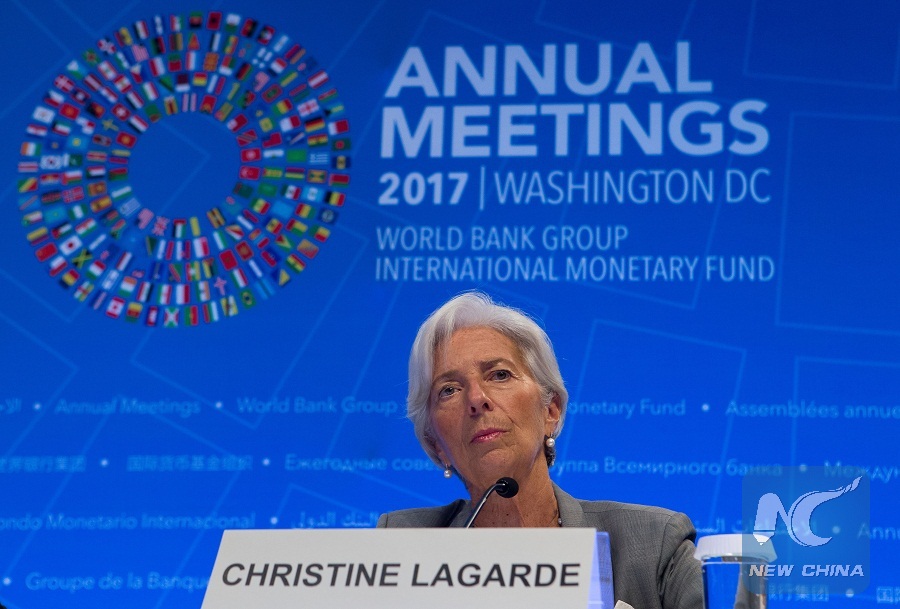
(File Pic) IMF said Tuesday non-oil growth is expected to drive economic recovery in Saudi Arabia and the United Arab Emirates (UAE) in 2018. (Xinhua Photo)
DUBAI, Oct. 31 (Xinhua) -- Non-oil growth is expected to drive economic recovery in the United Arab Emirates (UAE) and Saudi Arabia, the two economic powerhouses in the Middle East, said a senior official of the International Monetary Fund (IMF) on Tuesday.
The International Monetary Fund's (IMF) regional director of the Middle East and Central Asia department, Jihad Azour, said non-oil growth is expected to drive economic recovery in the two biggest Gulf Arab countries, while consumer price inflation will also pick up despite the a projected steady price of oil at current levels in 2018.
Briefing the media on the Middle East and North Africa regional economic outlook, Azour quoted the IMF's analysis which states that real gross domestic product (GDP) growth for the United Arab Emirates (UAE) is expected to rise to 3.4 percent in 2018, up from 1.3 percent this year.
Growth in Saudi Arabia, the biggest Gulf co-operation council (GCC) economy is project to pick up to 1.1 percent in 2018 from near stagnation (plus 0.1 percent) in 2017, although the IMF has revised its projection for the price of oil down from 55 dollar per barrel (159 liter) to 53 dollar per barrel for 2018.
"Despite the extended agreement of oil exporting nations of the OPEC to reduce oil production until the first quarter of 2018, we do not expect the price of oil to rise on average in the next year," explained Azour.
However, consumer price inflation is projected by the IMF to rise to 2.9 percent in 2018 from 2.1 percent in the UAE and to 5.0 percent from minus 0.2 percent in Saudi Arabia, "as the implementation of a five percent value added tax in both countries from January 1st 2018 onward will have some impact on price development," said Azour.
He urged both countries to ease access to capital for small and medium-term enterprises and to improve labor skills in order to spur growth.
"Both countries will see a pickup in non-oil growth and benefit from a recovery of the world economy, while the UAE witnesses increased investment activity from investments for the upcoming Expo 2020," he said.
The Washington-based IMF, a multi-national institution which monitors global financial stability and which provides technical advisory to governments on their economic policy has earlier in the month revised global growth forecast upward by 0.1 percent for both 2017 and 2018 to 3.6 percent and 3.7 percent, respectively.
An encouraging development in the UAE, said Azour, is the fact that it belongs to those Arab oil export nations which made "substantial progress in establishing medium-term budgetary frameworks at both the federal and emirate levels."
In addition, the UAE as the economically most diversified Gulf Arab state has made welcome reforms to its visa systems, allowing greater internal mobility of expatriate workers.
Over 80 percent of the 10 million inhabitants of the UAE are foreigners and they represent the majority work force across all private sector industries.
The Kingdom of Saudi Arabia, on the other hand, has yet to improve the legal conditions to allow better internal mobility of expatriate workers, said Azour.
On the downside risks, Azour noted that a protracted rift between the UAE, Saudi Arabia and Qatar could weaken medium-term growth prospects, "not only for Qatar, but for other Gulf states of the GCC."
On June 5 2017, Saudi Arabia and the UAE, along with Bahrain and Egypt cut diplomatic ties with Qatar and imposed a sea, land and air transport embargo on the gas-rich state, accusing its government of supporting "terrorism," a charge which Qatar denies.
A further tightening of monetary policy in the United States by the Federal Reserve could increase costs of financing in both the UAE and Saudi, too, as their currencies are pegged to the U.S. dollar.

